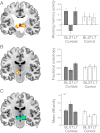Persistent and reversible consequences of combat stress on the mesofrontal circuit and cognition
- PMID: 22949649
- PMCID: PMC3458361
- DOI: 10.1073/pnas.1206330109
Persistent and reversible consequences of combat stress on the mesofrontal circuit and cognition
Abstract
Prolonged stress can have long-lasting effects on cognition. Animal models suggest that deficits in executive functioning could result from alterations within the mesofrontal circuit. We investigated this hypothesis in soldiers before and after deployment to Afghanistan and a control group using functional and diffusion tensor imaging. Combat stress reduced midbrain activity and integrity, which was associated to compromised sustained attention. Long-term follow-up showed that the functional and structural changes had normalized within 1.5 y. In contrast, combat stress induced a persistent reduction in functional connectivity between the midbrain and prefrontal cortex. These results demonstrate that combat stress has adverse effects on the human mesofrontal circuit and suggests that these alterations are partially reversible.
Conflict of interest statement
The authors declare no conflict of interest.
Figures



Similar articles
-
Connecting combat-related mild traumatic brain injury with posttraumatic stress disorder symptoms through brain imaging.Neurosci Lett. 2014 Aug 8;577:11-5. doi: 10.1016/j.neulet.2014.05.054. Epub 2014 Jun 4. Neurosci Lett. 2014. PMID: 24907686
-
Neural indicators of interpersonal anger as cause and consequence of combat training stress symptoms.Psychol Med. 2017 Jul;47(9):1561-1572. doi: 10.1017/S0033291716003354. Epub 2017 Jan 5. Psychol Med. 2017. PMID: 28052779
-
Stress-induced reduction in hippocampal volume and connectivity with the ventromedial prefrontal cortex are related to maladaptive responses to stressful military service.Hum Brain Mapp. 2013 Nov;34(11):2808-16. doi: 10.1002/hbm.22100. Epub 2012 Jul 17. Hum Brain Mapp. 2013. PMID: 22807242 Free PMC article.
-
[The most frequent stress syndromes in soldiers in war].Vojnosanit Pregl. 2004 Nov-Dec;61(6):675-82. doi: 10.2298/vsp0406675c. Vojnosanit Pregl. 2004. PMID: 15717730 Review. Serbian. No abstract available.
-
Neurocognitive functioning in posttraumatic stress disorder.Neuropsychol Rev. 2002 Mar;12(1):15-30. doi: 10.1023/a:1015439106231. Neuropsychol Rev. 2002. PMID: 12090717 Review.
Cited by
-
Treatment Outcome-Related White Matter Differences in Veterans with Posttraumatic Stress Disorder.Neuropsychopharmacology. 2015 Sep;40(10):2434-42. doi: 10.1038/npp.2015.94. Epub 2015 Apr 3. Neuropsychopharmacology. 2015. PMID: 25837284 Free PMC article.
-
The Molecular Biology of Susceptibility to Post-Traumatic Stress Disorder: Highlights of Epigenetics and Epigenomics.Int J Mol Sci. 2021 Oct 4;22(19):10743. doi: 10.3390/ijms221910743. Int J Mol Sci. 2021. PMID: 34639084 Free PMC article. Review.
-
Twenty Years of Blast-Induced Neurotrauma: Current State of Knowledge.Neurotrauma Rep. 2024 Mar 14;5(1):243-253. doi: 10.1089/neur.2024.0001. eCollection 2024. Neurotrauma Rep. 2024. PMID: 38515548 Free PMC article.
-
A resting-state network comparison of combat-related PTSD with combat-exposed and civilian controls.Soc Cogn Affect Neurosci. 2019 Sep 30;14(9):933-945. doi: 10.1093/scan/nsz072. Soc Cogn Affect Neurosci. 2019. PMID: 31588508 Free PMC article.
-
Effect of GHB-use and GHB-induced comas on dorsolateral prefrontal cortex functioning in humans.Neuroimage Clin. 2018;20:923-930. doi: 10.1016/j.nicl.2018.09.022. Epub 2018 Sep 26. Neuroimage Clin. 2018. PMID: 30308378 Free PMC article.
References
-
- Hoge CW, et al. Combat duty in Iraq and Afghanistan, mental health problems, and barriers to care. N Engl J Med. 2004;351:13–22. - PubMed
-
- Vasterling JJ, et al. Neuropsychological outcomes of army personnel following deployment to the Iraq war. JAMA. 2006;296:519–529. - PubMed
-
- The Iowa Persian Gulf Study Group Self-reported illness and health status among Gulf War veterans. A population-based study. JAMA. 1997;277:238–245. - PubMed
-
- Sayer NA, et al. Reintegration problems and treatment interests among Iraq and Afghanistan combat veterans receiving VA medical care. Psychiatr Serv. 2010;61:589–597. - PubMed
-
- Sapolsky RM. Why stress is bad for your brain. Science. 1996;273:749–750. - PubMed
Publication types
MeSH terms
Substances
LinkOut - more resources
Full Text Sources
Other Literature Sources
Medical
Molecular Biology Databases

